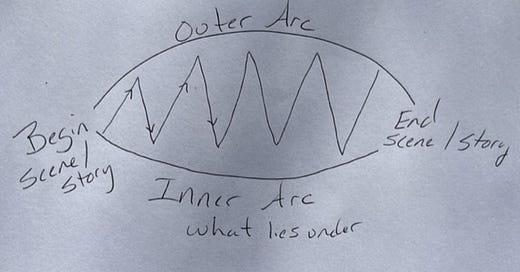🎧 The Hidden Engine of Great Stories: Mastering Inner and Outer Arcs
Why your memoir needs two parallel journeys - and how to weave them together
An Exclusive Writing Lab post on inner and outer arc, Grace Paley, and a working example from the opening post “getting to know you.”
There is no story that is just one story. Every story is two stories. It is the one on the surface and the one that is bubbling beneath. And the climax is when those two stories collide.
~ Grace Paley
Welcome into Flight School:
Great stories are a double helix tapestry of outer and inner arc. The outer arc provides the strong warp threads - the timeline that holds everything together. The inner arc weaves through these events, creating patterns of meaning and emotion. When memoir writers understand this interplay, they move beyond just documenting events. They create work that resonates deeply with readers because it reflects how we actually experience life: as both external events and internal transformations happening simultaneously.
The Two Threads of Story
The Outer Arc (OA): Your timeline of events, the what-happened
The Inner Arc (IA): The emotional current running beneath, reshaping everything
Why This Matters for Memoir
Many memoir writers fall into the trap of cataloging events: This happened. Then that happened. Then this other thing happened. That's reporting. Great memoir requires both horizontal movement (time) and vertical depth (meaning).
Let's See It in Action: Simple to Complex
The Coffee Story
Take the simplest story: Someone wants coffee.
**Outer Arc**: They walk to the café, order, and leave with coffee in hand.
**Inner Arc**: But why this desperate need for caffeine? What drives their addiction? What are they trying to stay awake for - or stay awake to avoid? Even this basic scenario shows how inner and outer arcs create depth.
The Marriage Story
Another example came from our launch story about an unlikely marriage:
Outer Arc: "He wanted the full American dream: home ownership, 401K, reliable cars, kids, steady jobs."
Inner Arc: "I was okay having a reliable car (how else to hit the road in a hurry) but a house? Investments? Kids? No. No. No."
See how outer and inner dance together? Outer events reveal the inner struggle.
The Deeper Dance
Going a step deeper, now notice how each outer event (**OA**) triggers an inner revelation (**IA**):
**OA**: "He wanted the full American dream..."
**IA**: Each element of that dream reveals my deep resistance to being "locked down"
**OA**: "Reader, I married him"
**IA**: That choice opened the door to understanding my own story. This is how external choices reveal internal truth.
Your Turn
✍️ Look at your catalyst story from our first post. Mark the OA (outer events) and IA (inner revelations). What patterns do you notice? Share your discoveries in the comments.
Bonus challenge: Try mapping the six mini arcs in our Fisher King story from "What Ails Thee?"
~ Jennifer 🐦⬛








Thanks for this, Jennifer! Having written first "shitty draft" of my memoir, my first editor noted that I must go deeper into my emotions on a lot of the chapters. I "tell the story" but don't tell the inner arc very well in some pieces of it.
Why can it be difficult? I think it's because it's the "being vulnerable" part of writing your story. Yes, we can go back in time and describe the events that we remember, but why do we remember them? Maybe (probably?) because there is an emotion behind the memory. We have to dig around a bit for that emotion to come back to us--what were we feeling, really feeling, about that memory that makes it worth sharing? THIS is, I think, why I was compelled to write my story: to dig around, loosen those emotional pieces, bring them to light, and make sense of them.
I've written in terms of The Heroine's Journey, but I love thinking of writing with the inner and outer arcs, bringing them together in the end.
You make something so difficult so much clearer. My agent had to really push me to dig deeper in my proposal, in the sample chapter and chapter summaries. It's so hard not only to share the vulnerability but to even get to a place where you uncover it. Your explanation of the inner arc and outer arc make for a really tangible "formula."
As I was reading Tracy's comment about why we remember certain things, I thought about a scene in my book where my dad said he almost got carried off his front porch during a flood. I mention it in my book but I don't do an inner arc, and I've never really gotten to a point where I know what that inner arc would be. But reading Tracy's comment, I realized it aligns with a main theme in my book... that my dad was always about to slip away. The flood was one of the first times it felt like my dad could just vanish. I'm so going to add this realization to the scene!